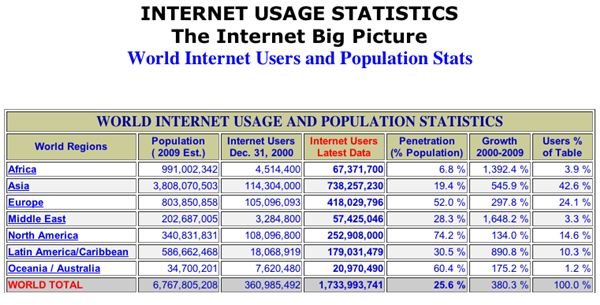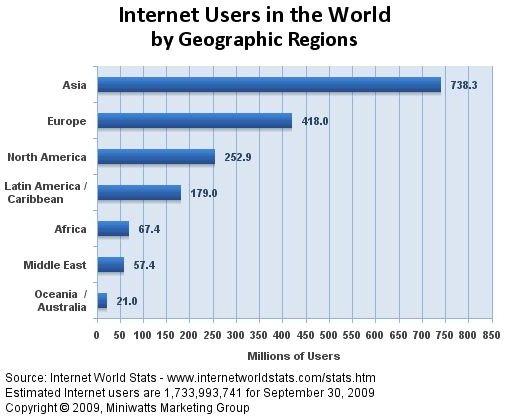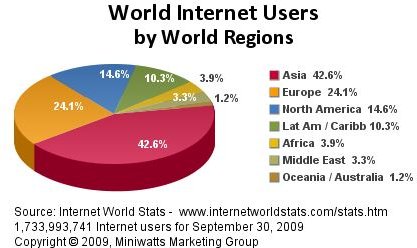Worldwide Broadband Statistics and Trends
Internet World Stats
One of the best resources online for Internet usage statistics is Internetworldstats.com. (Images and charts used with permission from InternetWorldStats.) Here you’ll find compiled data of Internet usage listed by country. You may be surprised at some of the statistics. They have a prominent link on their web page called “the big picture,” which will give you a perspective on all those global Internet stats you’re looking for. You may want to browse statistics and the many web links as they are fascinating for analysis or general knowledge. Here are some of the trends:
Market Penetration and Saturation
First you must be familiar with two terms: Market Penetration and Market Saturation. This means the number of people who have fully adopted broadband Internet use on a regular basis, recorded as the number of broadband account subscriptions as a percentage of the total population. Not surprisingly, the more economically developed nations have much higher market penetration and saturation rates than say, third world countries. These percentages are interesting indicators of how enthusiastic a country or region is about their Broadband Internet Access. It also gives you a glimpse of who the laggards are.
Basic Global Data: The 25-Percenters
One in four people on the planet have regular access to broadband Internet (or 25 percent.) This is approximately 1.5 Billion people out of 7 Billion on the planet (source: Internet WorldStats.com). This is a fast growing segment, as you should note that in 2005 only 15 percent of the world population had high speed web access. This is a 60 percent increase from 5 years ago.

Consider Yourself Lucky
If you are reading this on a computer via the web (or on a mobile phone, iPad or netbook ) you currently have Internet access. Consider yourself among the lucky. This means you are one of the most technologically advanced citizens on the planet (or at least in the top quarter). So if you are reading this article right now via the Internet count yourself among the elite 25-percent of computer-savvy and technically-proficient current Internet users; perhaps your government even created broadband access initiatives (like South Korea.)
At any rate, we are the global 25-percenters. We 25-percenters should know that the other 75 percent of people on the planet still do not use the Internet regularly. Chances are you are enjoying one of the many technological advantages of living in a fully developed and economically powerful industrialized nation (much of the planet’s population has neither phone or automobile either, but that’s another story), or better yet riding on the wave of the Information Age. Countries that are already technologically adept have deep economic, technological, and academic infrastructures that make this possible. Hear that USA? We need more government initiatives so that everyone can have broadband Internet access- like mobile and telecom pioneers Scandinavia and the WiBro and highly saturated gaming communities of South Korea.
China, India and Asia
Due to their significantly larger populations, China and India lead by sheer numbers. Also it may surprise you that there are more Chinese speaking people using the Internet than any other language. China far and away leads with nearly a billion Internet users while the US boasts only one-third of that (approximately 275 Million US users to China’s 900 or so million). Population-wise, Mandarin Chinese speakers outnumber English speakers on the Internet 3 to 1. That’s right! Chinese is the #1 most spoken language on the Internet. And Asia has the most number of Internet users. You can look at the charts to see what I mean.


Summary
So as the rest of the world comes around to seeing the value of instantaneous global communication, many of us are already here. But don’t blame the people who live in underdeveloped countries. Some countries simply lack infrastructure or incentives to do this. Others countries have rolled out massive public broadband plans along with miles and miles of fiber optic cable. Some already have hybrid infrastructures of coaxial cable, phone lines, electricity lines, satellite connections, or radio towers available to enable broadband more quickly. Also, incentives for growth, government regulations, and public demand all play a role in this. Some of us take the Internet for granted, like it’s a utility similar to water or electricity, but then again many places don’t even have that.
